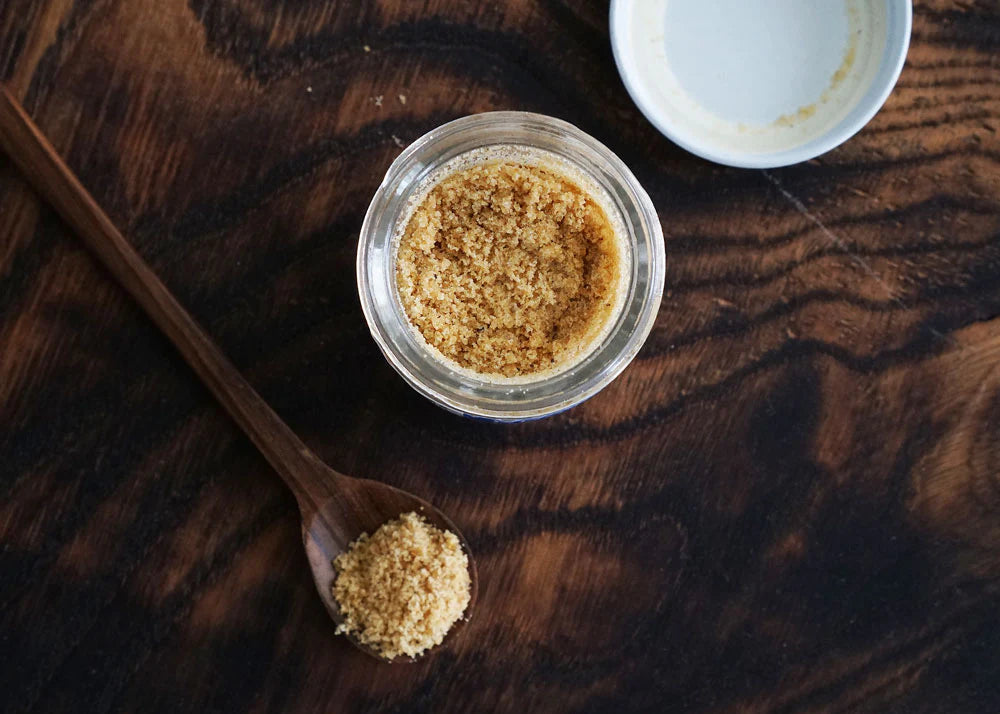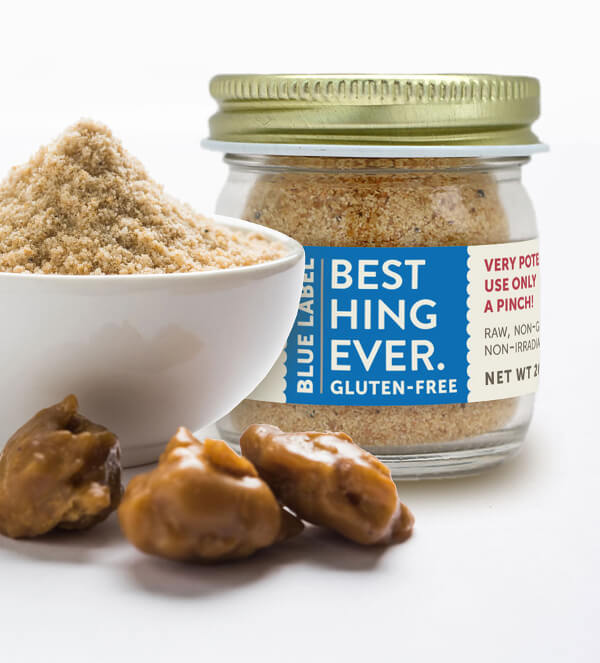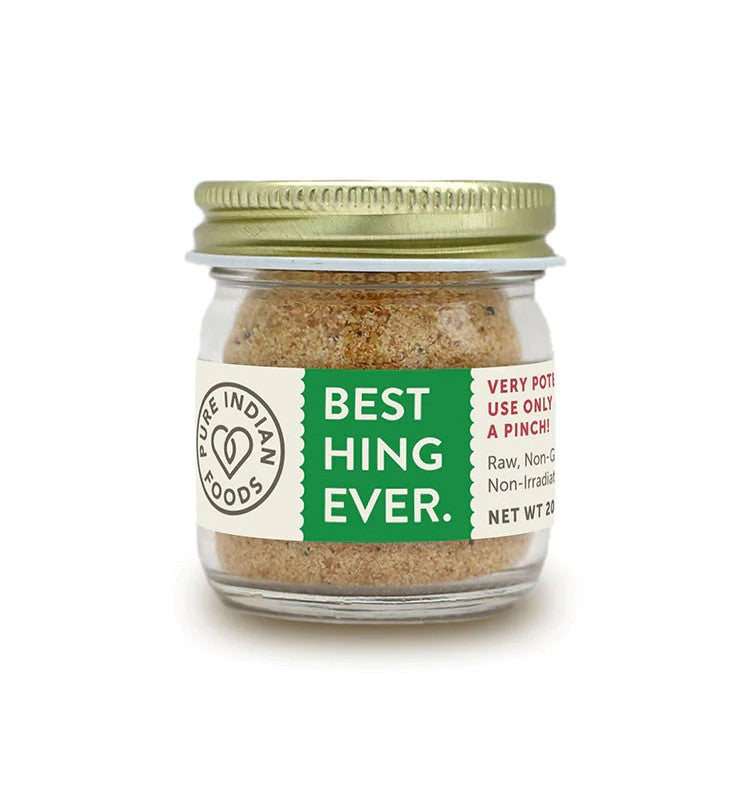
Try it now.
Hing, also known as Asafetida Powder, is the secret weapon of Indian cuisine. Aromatic and pungent, a tiny pinch makes every other spice shine.

We make other brands taste like sawdust.
Our Hing is wild-crafted with no useless fillers or anti-caking agents. It's literally the best asafetida powder that you can buy.

Just a pinch will do.
Hing, or Asafetida Powder, comes from the dried resin of a giant fennel-family plant that grows in the wild. In the United States, it's mostly found ground into a powder and mixed with wheat, starches, and anti-caking agents. We don't do that.
We keep ours pure and raw, making it 8 to 10 times stronger than the compounded hing you'll find elsewhere. You'll only need a tiny pinch to flavor an entire dish!
Our Story.
-

Sandeep and the Best Hing Ever.
A match made in heaven.
-
How it Started.
Growing up in India, Sandeep had fond memories of his mother using hing in her cooking. She'd melt ghee in a pan, add a tiny pinch of hing, and immediately their home would be filled with the beautiful, almost garlicky aroma. When he eventually moved the U.S., he was shocked by the terrible quality of hing available here...
-

Packaged in small batches by hand.
With love and care.
"It really is the Best Hing Ever."
"My mom gave me a couple of bottles of hing but I couldn't stand the smell of them and threw them out. This one actually has a nice smell and taste. I love the fragrance of your hing in all my foods when I use it in 'Tadka.' It is very authentic."
and
"I got this to use in place of onions and garlic because of my allium allergy. It's a pretty good substitute. You really only do need a pinch. It's particularly good."
All About Hing.
-

-
Devil's Dung or God's Food?
As controversial as it is strong, Asafetida Powder has a long history of being equally loathed and loved. If improperly produced, it can small fetid. Ours is aromatic and pleasant.
-

What is it?
Growing up in an Indian home, asafetida (also spelled asafoeitida, and in Hindi, hing) is like oxygen. It's in the air you breathe. It's in the food you eat. It's synonymous with love and family and shared meals and warm comfort. But here in the U.S., no one seems to know what it is.
Even people who can confidently whip together a few gorgeous Indian dishes are puzzled by hing. They've never heard of it, don't know how to use it, and don't know where to buy it.
Asafetida is the secret weapon of Indian cuisine. It's the spice that makes every other flavor come together into a harmonious whole. So how do you cook with it?

Cooking with Hing.
The real trick to cooking with asafetida is to recognize two things:
One, you only need a pinch! Add too much and it will overpower your dish.
Two, it needs to be used in the beginning stage of cooking by adding it to heated oil, preferably ghee. This mellows the flavor and scent into something more akin to leek or garlic. You can't just sprinkle it on top of any dish like you can dried garlic granules or table salt. That would be unpleasant. Yet adding it to heated oil truly makes it shine and helps add its special funk to any dish.
The purpose of it in Indian food can't be overstated. A little bit of hing in your pan supercharges ever other spice, making your entire dish more aromatic and flavorful and giving any recipe an addictive depth. It can also be very helpful for those looking for alternatives to onion and garlic because of an allium allergy.
Read more about how to cook with hing.
But asafetida is more than just a culinary spice, it's also a medicinal powerhouse with a rich history.
The History of Asafetida
The history of hing traces back to ancient times, where it is believed to have grown wild in the rugged landscapes of Afghanistan, catching the attention of various civilizations. As trade routes expanded across Asia, so did the reach of hing.
The spice found its way west into Persian and Middle Eastern cuisines, and east into Central Asia, adapting to diverse culinary traditions. The name "asafoetida" (also spelled asafetida) itself is derived from the Persian word "aza," meaning resin, and the Latin word "foetidus," meaning smelling strongly. It eventually came to India from Afghanistan as early as 600 BCE (it's mentioned in Buddhist and Hindu texts from the time).
In India, hing continued to be a widespread culinary staple. Its unique pungent flavor made it a key component in vegetarian dishes, particularly in regions where the use of onion and garlic was restricted for religious or cultural reasons. The Manasollasa, a 12th-century compendium authored by King Somesvara II, a monarch from South India, extensively documented the utilization of asafetida.
In 1563, the Portuguese naturalist and physician Garcia de Orta acknowledged the spice's significance in everyday Indian life in his work Colloquies on the Simples and Drugs of India (1563), considered the first scientific book on oriental spices published in the Western world. He highlighted its widespread use, emphasizing its role not only in medicine but also as a favored seasoning among the Hindu population in India.

Hing in Traditional Medicine
Across cultures and continents, hing maintained its status as a medicinal powerhouse. In traditional medicine systems like Ayurveda, Unani, and traditional Chinese medicine, asafetida was prescribed for digestive issues, respiratory disorders, and as a general tonic. Its anti-spasmodic and anti-inflammatory properties were valued for their therapeutic effects.
Modern Applications and Scientific Validation
In the modern era, scientific research has caught up with ancient wisdom, shedding light on the pharmacological properties of asafetida. Studies have confirmed its potential efficacy in treating various digestive disorders, from indigestion to irritable bowel syndrome. The anti-inflammatory and antimicrobial properties of hing have also been scientifically validated, supporting its traditional uses in managing arthritis and wound healing.
As the world becomes increasingly interconnected, hing continues to transcend cultural boundaries. Its versatility in both healing and culinary domains ensures its relevance in diverse global contexts. With the growing interest in Ayurveda and traditional cuisines, asafetida is experiencing a resurgence in popularity, finding its way into kitchens around the world.

So Which Hing Should You Buy?
When it comes to this particular spice, you absolutely cannot compromise on quality. Otherwise, you'll get stuck with something that smells off-putting and tastes unpleasant.
These days, the most commonly available form of hing is compounded asafetida, a fine powder containing only 30% asafetida resin, along with rice flour or maida (white wheat flour). Rather than buying these compounds, opt for hing that is free from additives, fillers, or any unnecessary preservatives.
Pure hing should be the sole star of the show in your spice collection. The best hing powder will contain the hing resin, trace amounts of an edible gum (like that from the acacia tree) to prevent caking, and absolutely nothing else. It will be raw, wild-crafted, non-GMO, non-irradiated, and wheat-free. It will be 8-10 times stronger than its compounded asafetida counterparts, so you'll only need a pinch to season an entire dish.

Buy it now.
No other asafetida is as pleasantly aromatic. No other hing is as potent. This is the spice as it's meant to be — wild-crafted, pure, raw, wheat-free, non-GMO, non-irradiated, with no unnecessary fillers or preservatives.
How Should You Store Your Asafetida?
Because of its strong scent, you will absolutely want to store your hing well. Improper storage of low-quality asafetida is the primary reason why it has gotten such a bad reputation for being stinky or off-putting. There's no getting around how powerful the raw spice is, and it will permeate every other spice in your cabinet if you don't store it properly. Nobody wants to bite into their chocolate chip cookie and taste hing instead!
Hing is sensitive to light, air, and moisture, and improper storage can compromise its quality as well as cause its pungent scent to spread throughout your kitchen. So the trick is to store it in a cool, dark, dry place, away from direct sunlight or heat sources and in airtight containers, preferably made of glass with a well-sealed lid. This prevents exposure to air and maintains the spice in a controlled environment.
When you adhere to these storage guidelines, the best quality asafetida doesn't really "go bad." It may lose some of its pungency with time, but you should still be able to infuse your dishes with its authentic and robust flavor.
Frequently Asked Questions
Does your hing smell?
All hing has a strong scent. We like to say ours smells "pleasantly aromatic" compared to other brands. In English, it is called both “hing” and “asafetida.” Asa comes from the Persian word azā, which means “resin,: and foetidus means “smelling, fetid.” The smell—and thus the flavor—of raw hing is highly pungent, but when the right amount is heated in a fat, such as ghee, the aroma and flavor mellow beautifully into something akin to fragrantly sautéed leeks, onions, shallots and garlic. Its characteristic odor comes from sulfur compounds in the fennel resin. Some people love it; some people hate it—just like onions or garlic.
Is hing a good substitute for garlic & onions?
Yes! Asafetida is an essential ingredient in Southern Indian vegetarian cooking, and an ideal substitute for onion and garlic. For more information on this, read Substituting Hing for Garlic & Onions.
Is asafetida (hing) low FODMAP?
Yes. It has been lab-tested by Monash University and is on their list of recommended low FODMAP herbs and spices.
If you're on a low FODMAP diet to treat SIBO or IBS, asafetida powder is a safe allium alternative! The key is to make sure that the spice you're using is free of wheat flour, starch, or other unsuitable anti-caking agents or preservatives. Thankfully, our hing really is the best ever. Unlike most other brands, ours is 100% raw and non-irradiated and is wheat and starch free.
Is your asafetida (hing) gluten-free?
We offer three asafetida (hing) products:
- Green Label (Powder)
- Blue Label (Powder, Batch-Tested Gluten-Free)
- Gold Label (Lumps, Batch-Tested Gluten-Free)
Both of the powder products have exactly the same ingredients in the same ratios. The only difference is that Blue Label is batch-tested gluten-free and the Green Label is not tested. The lump hing is also gluten-free because it is 100% pure resin.
Is asafetida the same thing as hing?
Yes! Called asafetida (also spelled asafoetida) in English, it's also known as hing (or heeng) in Hindi.
What does it taste like?
Just a pinch of our wild-crafted pure hing gives food an invitingly aromatic onion-garlic flavor, which is especially good in curries, vegetarian dishes, and stews. It provides the base notes to almost all Indian cuisine, so much so that you'll immediately notice if it's missing!
Do you recommend hing for its health benefits?
While it does have a history of being recommended in Ayurveda, and may also have many verifiable therapeutic benefits, we are not doctors! We strongly suggest you speak with your practitioner or doctor for any medical advice related to asafetida.



